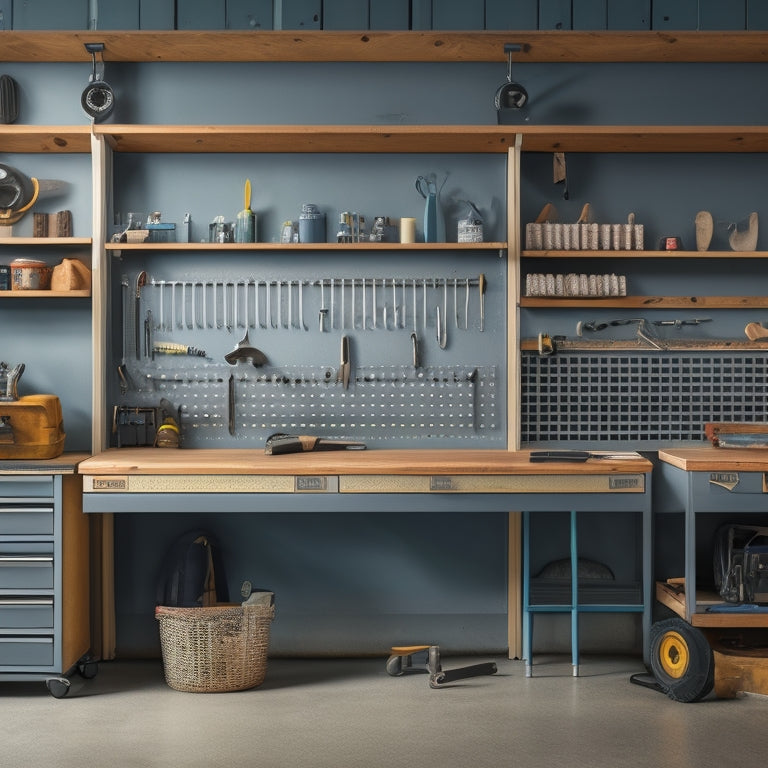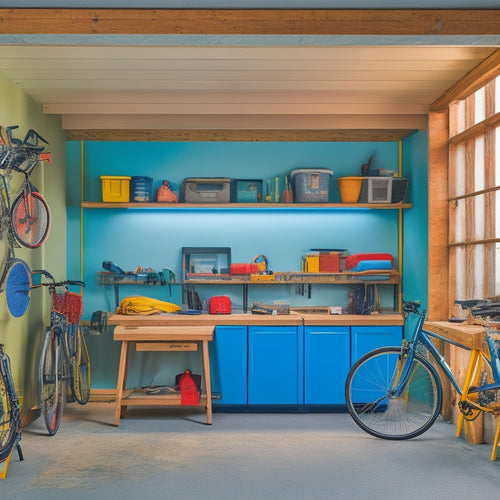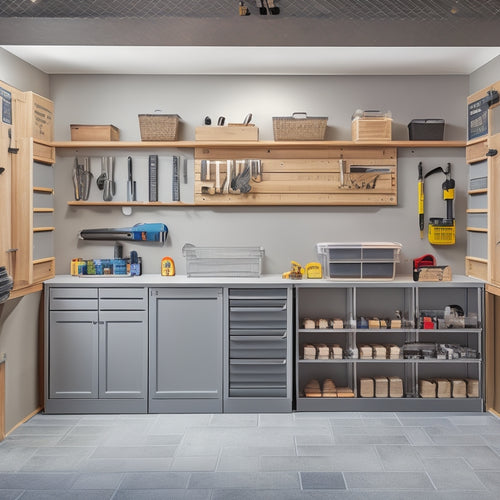
Streamline Your Workshop: Essential Tool Storage Solutions
Share
You waste valuable time searching for tools and equipment in your cluttered workshop, decreasing productivity and increasing frustration. To streamline your workshop, start by maximizing vertical storage space with wall-mounted shelves and hanging tool racks. Optimize corner areas with custom shelving and creative storage ideas. Implement a pegboard organization system with tool shadowing, modular hooks, and color coding. Compact storage solutions, like tool chests and small part containers, keep small tools organized. Finally, use labeling and signage best practices to guarantee easy tool identification and accessibility. Now, take the next step towards a more efficient workshop...
Key Takeaways
• Implement vertical storage solutions like wall-mounted shelves and overhead storage racks to maximize limited floor space.
• Optimize corner storage with shelving, creative ideas, and repurposed furniture to increase storage capacity.
• Utilize pegboard organization strategies, including tool shadowing and color coding, for quick tool identification and customizable storage.
• Invest in compact storage solutions like tool chests, magnetic strips, and small part containers to organize small tools and supplies.
• Implement labeling and signage best practices, including color coding and visual aids, to reduce time spent searching for tools and equipment.
Maximizing Vertical Storage Space
To maximize your workshop's vertical storage space, start by installing shelves, hooks, or a pegboard on walls and ceilings to keep frequently used tools and accessories within easy reach. This will help you make the most of your workshop's limited floor space.
Consider wall mounted shelves for storing larger items like power tools, and hanging tool racks for organizing hand tools.
For overhead storage, look into stacking bins that can be suspended from the ceiling. These are perfect for storing items like nuts, bolts, and screws.
You can also use overhead storage racks for infrequently used items like seasonal decorations or out-of-season equipment.
Efficient Use of Corner Areas
Having optimized your workshop's vertical storage space, you're now ready to tackle the often-wasted corner areas, where a few clever strategies can turn awkward nooks into valuable storage zones.
Corner shelving is a great space-saving solution, allowing you to store infrequently used items or bulky tools without taking up valuable floor space. Install adjustable shelves or carousels to maximize storage capacity and accessibility.
Consider creative corner storage ideas, such as a pegless corner shelf or a rotating corner cabinet. These innovative solutions enable you to store items like power tools, hand tools, or supplies, keeping them organized and within reach.
You can also repurpose old furniture, like an old bookshelf or cabinet, to create a unique corner storage unit.
When designing your corner storage system, think about the items you need to store and how often you'll access them. This will help you determine the best layout and configuration for your corner space.
Optimizing Pegboard Organization Systems
You can amplify your workshop's storage capacity and accessibility by designing a pegboard organization system that's tailored to your specific needs and tool collections. A well-planned pegboard can help you maximize space, reduce clutter, and increase productivity. To get started, consider the following strategies:
| Technique | Benefits |
|---|---|
| Tool Shadowing | Visual cues help you quickly identify tool locations, reducing search time and increasing efficiency. |
| Modular Hooks | Adjustable hooks allow you to customize your pegboard as your tool collection evolves. |
| Color Coding | Labels and dividers in different colors help you categorize and prioritize tools, making it easier to find what you need. |
| Magnetic Strips | Strong magnetic strips keep small metal tools and accessories organized and within reach. |
Compact Storage for Small Tools
When it comes to compact storage for small tools, you'll want to focus on maximizing space while keeping your tools easily accessible.
You'll need to organize your tool chest, use small part containers to keep tiny items from getting lost, and implement drawer dividers to separate similar tools.
Tool Chest Organization
A well-organized tool chest with compact storage for small tools enables you to quickly locate and access the items you need, saving time and increasing productivity.
To achieve this, consider implementing a color-coding system, where you categorize tools by type or function and assign a specific color to each group. This visual system helps you quickly identify where a tool belongs and makes it easier to find what you need.
Another effective way to maximize storage in your tool chest is by using magnetic strips. These can be attached to the inside of the chest or on individual drawers, allowing you to store small metal tools like wrenches, pliers, and screwdrivers. This keeps them organized, prevents them from getting lost, and saves space that would be taken up by traditional storage methods.
Small Part Containers
Small part containers, such as tiny bins, cases, or drawers, provide compact storage for small tools, freeing up valuable space in your tool chest and reducing clutter. These containers are perfect for storing small items like screws, nuts, bolts, and other hardware. By using small part containers, you'll be able to find what you need quickly and easily, saving you time and frustration.
When selecting small part containers, consider the following factors:
| Feature | Description |
|---|---|
| Portability | Look for portable organizers that can be easily moved around your workshop. |
| Stackability | Choose stackable bins to maximize vertical storage space. |
| Size Options | Select containers that come in various sizes to accommodate different tool sizes. |
Drawer Dividers Ideal
Organize your tool chest drawers with dividers, and you'll be able to find what you need at a glance, making the most of your compact storage space. This is especially important for small tools that can easily get lost or jumbled together. With dividers, you can create customizable configurations that fit your specific tool collection. For example, you can create separate compartments for screwdrivers, pliers, and wrenches, or designate a section for frequently used hand tools.
Adjustable compartments allow you to adapt your storage space as your tool collection grows or changes. You can also use dividers to separate tools by project or task, making it easier to grab what you need when you need it. By maximizing your drawer space with dividers, you'll reduce clutter, save time, and increase productivity. Plus, you'll be able to see at a glance what tools you have and what you need to restock, making inventory management a breeze.
With the right dividers, you can turn your tool chest into a highly efficient and organized workspace.
Labeling and Signage Best Practices
You'll find that effective labeling and signage greatly reduce the time spent searching for tools and equipment, allowing you to stay focused on the task at hand. A well-structured labeling system helps you quickly identify where items are stored, making it simpler to find what you need when you need it.
To get the most out of your labeling efforts, consider using color coding and visual aids to categorize tools and equipment. For instance, you can use different colored labels to distinguish between hand tools, power tools, and accessories.
In addition to labeling, maintaining your signage over time is crucial. Set aside a few minutes each week to review your labels and signs, ensuring they remain accurate and relevant. This will prevent confusion and misplacement of tools.
Another organization hack is to keep frequently used items in easily accessible locations, while less frequently used items can be stored in more challenging-to-reach areas.
Mobile Storage Solutions for Tools
By investing in mobile storage solutions, such as carts, chests, and cabinets on wheels, you can bring your tools and equipment directly to the job site, saving time and increasing productivity. This allows you to work more efficiently and focus on the task at hand.
Tool cart versatility is a significant advantage, as you can customize it to fit your specific needs. For instance, you can add drawers, shelves, or trays to store various tools and accessories.
Portable toolboxes are another excellent option for mobile storage. They're perfect for smaller tools and supplies, and their compact size makes them easy to maneuver around the workshop or job site.
Rolling workstations and modular cabinets provide even more flexibility, as you can easily reconfigure them to suit different projects or tasks. These mobile storage solutions enable you to keep your tools organized and within reach, reducing downtime and increasing your overall efficiency.
Customizing Storage for Specialty Tools
When it comes to storing specialty tools, you'll want to contemplate customized solutions that cater to their unique shapes and sizes.
You'll need to ponder designing or selecting storage units that can securely hold and organize these tools, ensuring they remain protected and easily accessible.
Tool-Specific Shelving Units
Sixty percent of your tool collection likely consists of specialty tools that don't fit into standard storage bins, which is why investing in tool-specific shelving units can be a game-changer for your workshop's organization. These custom storage solutions guarantee each tool has a designated spot, making it easy to find what you need when you need it.
To maximize your workshop's space, consider the following tool-specific shelving units:
| Tool Type | Shelving Unit |
| Pneumatic tools | Vertical wall-mounted shelves with individual hooks |
| Power saws | Sliding tool specific racks with protective covers |
| Hand tools | Compact, horizontal shelves with dividers for organization |
| Measuring tools | Narrow, wall-mounted shelves with built-in trays for small items |
Adaptive Case Designs
You can take tool storage to the next level by designing adaptive case solutions that cater to your unique specialty tools, guaranteeing they're protected, organized, and easily accessible.
By creating customizable layouts, you can accommodate tools of varying shapes and sizes, guaranteeing a snug fit that prevents damage and scratching. Innovative materials like foam inserts or molded plastic can be used to create compartments that cradle each tool, keeping them secure and preventing them from shifting during transportation or storage.
When designing your adaptive case, consider the specific needs of each tool. For example, delicate electronics may require extra cushioning, while heavy machinery may need reinforced supports. By tailoring your storage solution to the unique requirements of each tool, you can guarantee that they're protected and organized, making it easier to find what you need when you need it.
With adaptive case designs, you can create a storage system that's as unique as your tools, guaranteeing that they're always ready to serve you and your clients.
Compact Drawer Systems
By incorporating compact drawer systems into your tool storage setup, you can maximize storage capacity while keeping your specialty tools organized and within easy reach. These space-saving solutions are ideal for workshops with limited floor space, allowing you to make the most of your available area.
To create an efficient layout, consider the following benefits of compact drawer systems:
-
Modular design: Modular drawer systems can be customized to fit your specific needs, with adjustable dividers and removable trays that allow you to reconfigure your storage as needed.
-
Drawer organizers: Incorporate drawer organizers, such as inserts and dividers, to keep your tools organized and easy to find.
-
Space-saving features: Look for compact drawer systems with features like soft-close drawers, ball-bearing slides, and compact handles that reduce the overall footprint of the system.
Frequently Asked Questions
Can I Repurpose Old Furniture as Tool Storage Solutions?
You can easily breathe new life into old furniture by repurposing it as creative tool storage solutions, boosting your workshop's efficiency and organization while reducing clutter, and getting the most out of your space.
How Often Should I Clean and Maintain Tool Storage Areas?
As you navigate your tool storage like a captain charting a familiar sea, you'll want to clean and maintain these areas regularly, ideally every 1-2 weeks, to prevent clutter and maintain organization tips and preventative maintenance keep your storage solutions shipshape.
What Are the Best Materials for DIY Tool Storage Projects?
When building DIY tool storage, you're deciding between wood vs metal materials. Wood offers a rustic touch, while metal provides durability. Get creative with organization ideas like slotted walls, bins, and hooks to maximize space.
Can Tool Storage Solutions Be Used for Other Workshop Items?
Can't you imagine a clutter-free workshop where everything has its place? You can repurpose tool storage solutions for other workshop items, achieving ultimate workshop organization with multi-purpose storage, maximizing space through creative solutions that boost efficiency.
Are There Tool Storage Solutions Suitable for Outdoor Workshops?
When setting up an outdoor workshop, you'll need tool storage solutions that can withstand the elements. Look for weatherproof options, portable solutions, customized racks, and secure cabinets to protect your tools from harsh weather and potential theft.
Related Posts
-

7 Essential Foldable Workbenches for Garages
When selecting a foldable workbench for your garage, you'll want to contemplate factors such as space-saving design, ...
-

Adjustable Modular Shoe Racks for Versatility
Adjustable modular shoe racks are your go-to solution for versatile and organized footwear storage. These racks maxim...
-

Essential Steps for Garage Storage System Design
You're about to change your cluttered garage into an organized haven by following a structured approach to garage sto...


